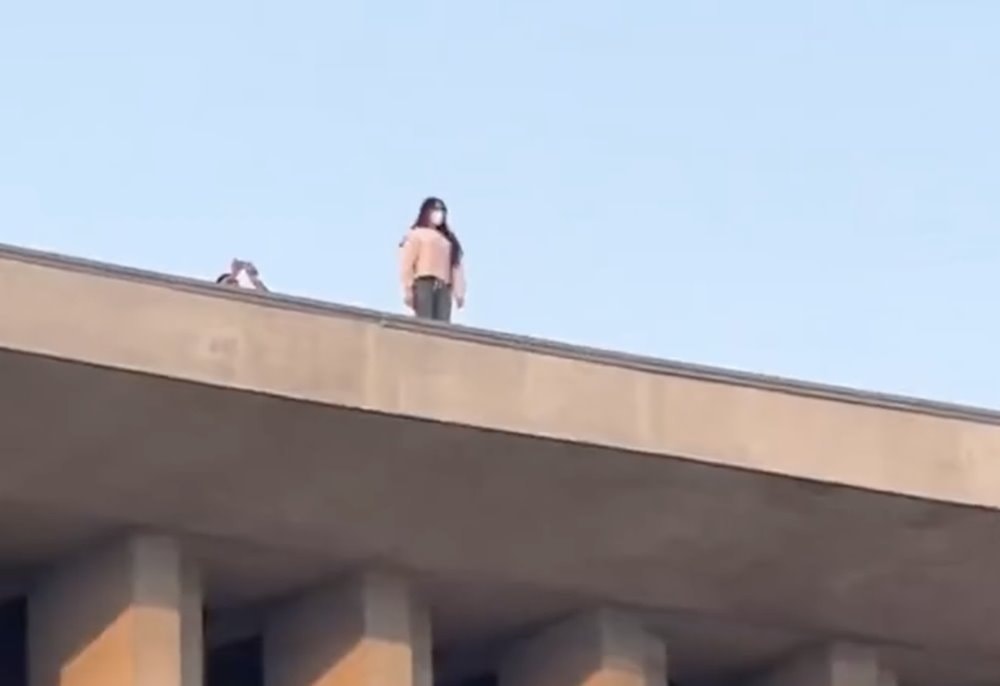Filling the gap in public etiquette
A story that has been shared with much criticism by the online community in the past few days is the image of a girl climbing onto the roof of the Vietnam Military History Museum (Hanoi) to film and take pictures. This is not only an offensive act but also shows the gap in the public behavior culture of a part of the youth.
From the beginning of this November,Vietnam Military History MuseumThe new museum in Nam Tu Liem district, Hanoi opened with free admission, attracting a large number of people and tourists to visit and explore. Over the past weekend, the museum welcomed a record number of visitors, up to about 40,000 people, causing traffic jams along Thang Long Avenue.
There were many visitors at the same time, while the Museum's human resources were lacking in managers, traffic controllers, guides, and interpreters, so many problems arose regarding security, order, and protection of artifacts. Visitors freely walked around, touched, and even climbed on artifacts displayed in the museum, leaving behind offensive images.

Most notably, the image of a girl climbing onto the roof of the Vietnam Military History Museum to pose for a photo and video, appearing in an 8-second clip that went viral on social media, has attracted the attention of many netizens. Many people expressed their indignation, criticizing the girl's lack of awareness, and at the same time, questioned the issue of security and order management at the museum.
There are problems with public etiquette.
Although we know that visitors, especially children, tend to want to explore and learn directly about the artifacts; and like to have impressive photos for themselves. But the act of climbing on the roof of the museum to twist, jump, and pose for photos is truly unacceptable.
This is not the first time that offensive images in public places, or at Vietnamese monuments, landscapes, and landscapes have been reported and criticized. Not long ago, the online community also expressed disagreement with the image of a Vietnamese woman wearing tight-fitting clothes, performing upside-down yoga outside the fence of Gyeongbokgung Palace (Seoul, South Korea).
Many people believe that the palace is a sacred place with special historical and cultural significance, so it is necessary to act seriously and discreetly to avoid causing offense. On a number of forums and newspapers in both Vietnam and Korea, the woman received harsh criticism.

Previously, in July this year, singer Duc Tuan also attracted attention when sharing a series of photos taken on the yin-yang tiled roof of an ancient house in Hoi An. Although Duc Tuan said he had the consent of the coffee shop owner to take the photo series, he later had to delete the post due to the fierce reaction of the online community. In recent years, Hoi An has also been repeatedly called out for the situation of tourists dressing indecently and inappropriately when visiting the old town with many hundreds of years old temples and pagodas. There were even tourists wearing bikinis, "letting loose" their breasts naturally in the old town, causing the community to be extremely upset.
Each ancient house in Hoi An is part of the World Cultural Heritage that UNESCO honored 25 years ago. Each brick and tile on the mossy ancient roofs that is still preserved today is a part of the memories of the people of Hoi An preserved over time. Stepping on them is stepping on the memories of the people, stepping on the heritage left by their ancestors. That is why people are upset.
How to fill the gap in public behavior culture?
The story of the girl climbing onto the roof of the Vietnam Military History Museum, or singer Duc Tuan climbing onto the roof of an old house in Hoi An to take photos, shows that there are still quite large gaps in the public behavior culture of the young generation.

It is not difficult for us to see fights after traffic collisions, stripping and jealousy in crowded places, posing on the baggage conveyor belt at the airport or smoking on the plane, regardless of safety regulations; swearing, cursing, writing and drawing on the wall...
Although these uncivilized behaviors only affect a few people, they are actually a big problem for society, as they happen every day, every hour and everywhere. This not only affects individuals but also affects the safety and comfort of those around them; it will cause big “cultural gaps” because “one mistake can lead to a thousand miles”. If not prevented, it will increase the risk of public order and security, create an unsafe environment for the community and can increase the risk of crime and conflict, reduce the quality of life and increase the feeling of insecurity for the community. More dangerously, uncivilized behaviors will negatively impact economic development and tourism. Because an uncivilized and unsafe environment can reduce the attractiveness of a destination to tourists and investors.
According to experts, this situation is caused by many reasons, one of the most important of which is the lack of awareness and the lack of deterrence in sanctions. Therefore, to "fill this cultural gap", strong measures are needed. "By strictly handling inappropriate behaviors, we contribute to creating a consensual, civilized, and safe social environment for everyone.
Visitors’ failure to comply with the regulations on protection of artifacts can be considered a violation of cultural heritage conservation. Therefore, it is necessary to improve management, supervision, and propaganda and dissemination to visitors. Cultural management agencies need to have clear regulations and support museums and relics in protecting artifacts. Each individual also needs to be aware of and respect historical artifacts and relics.
To build a civilized environment in public places, there needs to be coordination between management agencies as well as social organizations, especially young people such as the Youth Union, student organizations, etc. Organizing communication and education campaigns, and competitions on cultural behavior in public places will also be an effective way to raise community awareness.
Behaving civilly in public means respecting others and voluntarily obeying the law. Behaving civilly in public is part of creating cultural values. Each nation may have different levels of wealth, but the culture in each person and the level of civilization of the whole society is the foundation for sustainable development. It is considered one of the important measures and indicators of a country's spiritual culture. Therefore, along with the provisions of the law, each citizen needs to be responsible for creating that index through their own cultured behavior in crowded places./.
